Editor of this issue: Antanas V. Dundzila
Copyright © 1990 LITUANUS Foundation, Inc.

|
LITUANUS
LITHUANIAN QUARTERLY JOURNAL OF ARTS AND SCIENCES
Volume 36, No.2 - Summer 1990
Editor of this issue: Antanas V. Dundzila ISSN 0024-5089
Copyright © 1990 LITUANUS Foundation, Inc. |

|
LITHUANIA: AN OVERVIEW OF A STRUGGLE FOR NATIONAL SURVIVAL
DANUTĖ S. HARMON, PhD
Once again the three Baltic nations—Lithuania, Latvia and Estonia—are at a momentous juncture in their long and arduous history for national and cultural survival. Like the legendary phoenix, the Baltic people are rising from the ashes of destruction and oppression inflicted on them by two dictatorial powers during and after World War II. At best ignored as small and unimportant, at worst bartered against their will as inconsequential in the grand scheme of the world, Lithuania, Latvia and Estonia are now demanding to be heard.
I. A Brief Background
Lithuanians and Latvians are descendants of Aistians, the name given by scholars to the tribes called Aestiorum gentes by Tacitus (A.D. 56-120). Linguistically they belong to the distinct Indo-European family of Balts, based on Pliny the Elder's (A.D. 23-79) term Baltia for the area which they settled on the eastern shore of the Baltic Sea. Estonians speak a Finno-Ugric language.
Lithuanian culture to this day is a unique synthesis of ancient pagan traditions, fervent Christianity, and a decidedly Western modernism. Ancient mythology, folk art and customs remain a source of inspiration for various creative efforts, thus providing continuity and a strong sense of identity for its people.
Political organization of the Lithuanian people started in the 12th century, giving rise to independent powerful chiefs, or dukes. One of them, Mindaugas, united the separate principalities to found the Lithuanian medieval state in 1236. He is also credited with stemming the Tartar drive to Central Europe. In the 14th century, during the reign of Vytautas the Great, Lithuania's borders extended from the Baltic to the Black Sea. In the flux of history, the powerful rulers of Russia, Prussia and Austria partitioned most of Europe. The last partition of 1795 placed most of ethnographic Lithuania, Latvia, and Estonia under Russian rule.
But as empires disintegrated, the wave of national consciousness that swept Europe stirred in the Baltic provinces as well. During World War I, at the collapse of the Russian and German empires, the Baltic people seized the historic opportunity. On February 16, 1918, a National Council in Vilnius declared Lithuania independent and " . . . to be freed from any unions with other nations which previously had existed."1 Estonia and Latvia declared their independence on February 24, 1918, and November 18, 1918, respectively.
Peace treaties were signed with neighboring states and other European countries. On July 28, 1922, the United States recognized de jure the three Baltic states, which had already became members of the League of Nations the previous year. The treaty with the Soviet Union, signed by Lenin's ministers on July 12, 1920, is as follows:
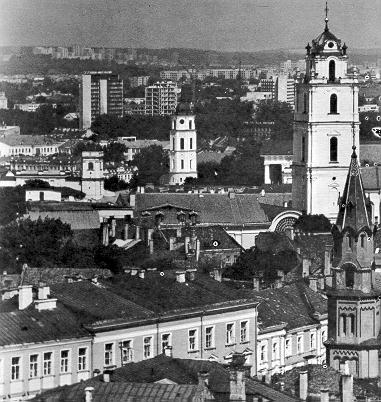
The city of Vilnius, the capital of Lithuania.
Photo by V. Kapočius
In conformity with the right declared by the Russian Socialist Federated Soviet
Republic of all peoples to a free self-determination, including the right to
full secession from the State of which they were a part, Russia
recognizes without any reserve the sovereignty and independence
of the State of Lithuania with all juridical consequences resulting from such
recognition, and voluntarily and forever renounces all sovereign rights
possessed by Russia over the Lithuanian people and territory.
The fact that Lithuania was
ever under Russian sovereignty does not place the Lithuanian people and their
territory under any obligation to Russia.2
The Soviet Union signed similar peace treaties with Estonia on February 2, 1920, and with Latvia on August 11, 1920.
On the basis of the above treaty with Lithuania, a Pact of Amity and Non-Aggression was signed on September 28, 1926, mutually agreeing . . . to respect their respective sovereignty and also their integrity and territorial inviolability in all drcumstances.3
The validity of this treaty was renewed on April 4, 1934, to be extended to December 31, 1941.4
Although now small (approximately 2.5 million inhabit-ants, and 21,000 sq. miles) compared to its former historical territory, Lithuania made enormous strides in responsible statehood during its brief life of independence. The entire country was energized by the spirit of renewal in socio-economic, as well as in educational-cultural areas. A radical land reform was implemented, accompanied by innovative and expanded agricultural practices. Cooperatives were introduced and a successful world market was developed for its products. It was able to maintain a gold standard despite world-wide depression. An advanced social security system was implemented, together with expanded public health care and facilities. Cumpulsory primary education, in conjunction with various adult consciousness raising pro-grams and organizations, eradicated the remnants of a tsarist legacy—illiteracy. A network of secondary and special schools sprang up, together with the establishment of universities, institutes and academies of higher learning, as well as conservatories and art schools. The cultural life was vibrant, a sports conscious youth was athletic and enthusiastic and all found expression in appropriate exhibitions and athletic competitions, not only on home soil, but abroad as well.
In all three Baltic states minorities (Jews, Russians, Poles, and others) were protected by law and were given equal political, economic and cultural rights, including freedom of religion and freedom to establish and maintain schools in their native languages, which were subsidized wholly or in part by the government.
In general, the independent Baltic states enjoyed a period of intense reconstructive activity and of relatively high stability. The future seemed bright, with promise to join other civilized Western democracies as their equals in all respects. But, it was not to be.
II. World War II
By 1939 most of Europe was wallowing in amoral political chaos, its leaders embracing the more expedient "policy of appeasement" and drifting towards an imminent war. As though prescient of events to come, in January 1939, the President of Lithuania was empowered to declare the country's neutrality, should the need arise. Yet this sane and judicious act did not safeguard it from becoming a pawn in the Machiavellian schemes of Hitler and Stalin. Thus, having just invaded Poland on September 1, 1939, Germany made repeated overtures to Lithuania to exploit the highly sensitive political situation by offering military assistance, if necessary, as well as assurance that Lithuania need fear no difficulties from the Soviet Union.
Germany and the Soviet Union had just signed a secret
Non-Aggression Pact on August 23, 1939, dividing Eastern Europe into "spheres of influence":
1. In the event of a territorial and political rearrangement in the areas belonging to the Baltic States (Finland, Estonia, Latvia, Lithuania), the northern boundary of Lithuania shall represent the boundary of the spheres of influence of Germany and the U.S.S.R. In this connection the interest of Lithuania in the Vilna area is recognized by each part.5
In this game of chess two former enemies were disposing of nations as though at whim: in the course of a month Lithuania was bandied first to the German "sphere," then to the Soviet "sphere" with the agreed price of $7.5 million in gold paid by the U.S.S.R. to Germany. On September 28, 1939, V. Ribbentrop and V. Molotov signed an amended protocol, which reads in part:
The Secret Additional Protocol
signed on August 23, 1939, shall be amended in item 1 to the
effect that the territory of the Lithuanian state falls to the
sphere of influence of the U.S.S.R. . . . As soon as the
Government of the U.S.S.R. shall take special measures on
Lithuanian territory to protect its interests, the present
German-Lithuanian border, for the purpose of a natural and simple
boundary delineation, shall be rectified in such a way that the
Lithuanian territory situated in to the southwest of the line
marked on the attached map falls to Germany.
Further it is declared that the
economic agreements now in force between Germany and Lithuania
shall not be affected by the measures of the Soviet Union
referred to above.6
While the aggregate of these agreements seems innocuous in tone and solicitous of peace in Europe, nevertheless they reveal a deadly game of deceit played with the unsuspecting, as well as with each other.
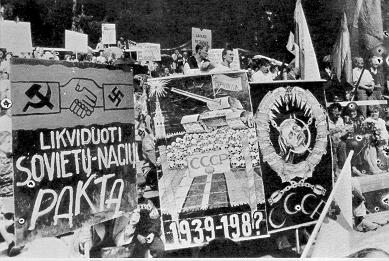
Demonstrators denouncing
the Molotov-Ribbentrop Pact.
Photo by V. Kapočius
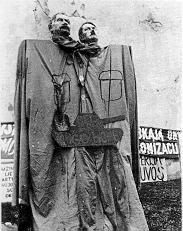
Effigy of Stalin and Hitler denouncing the Molotov-Ribbentrop Pact.
Photo By V. Kapočius.
When both powers invaded Poland in September 1939, the Soviet Union, having taken Vilnius and its territory, transferred it to Lithuania in exchange for a forced agreement to garrison Red Army troops on its soil. At the same time the Soviet renewed assurances of friendly relations and non-intervention in Lithuania's internal affairs, as well as respect for its independence.
The First Soviet Occupation. After the onset of World War II the Baltic states experienced three successive occupations: June 15,1940, by the Soviet Union; June 1941-1944 by Germany; and in 1944 again by the Soviet Union. All three were violent in their oppression, genocidal murders, and mass deportations. The tragic modern history of the Baltic countries has not yet been fully recorded. But the information available so far shows the horrific methods— other than warfare—that supposedly civilized governments carried out to destroy legitimate nations. It is conservatively estimated that Lithuania lost 500,000 inhabitants since June 1940.7
On June 15, 1940, the Red Army invaded Lithuania accompanied by the NKVD, and on August 3, 1940, forcefully and by fraud incorporated it as a constituent Soviet Republic.
Individual arrests, liquidations, and deportations began the night of July 11-12, 1940, when 2,000 people were arrested and never released. They were leaders of political parties, high government officials, influential public figures, and included both men and women.
The first mass deportation began at 4 a.m. on June 14, 1941. It is estimated that during several days between 30,000 and 40,000 Lithuanian men, women and children were packed in sealed boxcars and deported to Siberia and the Arctic regions of Russia. Many did not survive the journey. While the figures are not precise, facts and events are incontrovertible and are supported by documents and lists found in NKVD upon the hasty retreat of the Soviets from
Lithuania when attacked unexpectedly by Germany on June 22, 1941. The Soviet plan was to deport one-third of the population. The inhumanity of the system is obvious from an excerpt of instructions on procedures of handling deportees:
In view of the fact that a large number of deportees must be arrested and distributed in special camps and that their families must proceed to special settlements in distant regions, it is essential that the operation of removal of both the members of the deportee's family and its head should be carried out simultaneously, without notifying them of the separation confronting them. . . . only at the station of departure shall the head of the family be placed separately from his family in a car specially intended for heads of family.8
Before withdrawing from Lithuania, the NKVD murdered or took with them to Russia political prisoners incarcerated throughout the country: of 120,000 only approximately 300 were known to have survived.
The German Occupation. The German attack on the Soviet Union on June 22, 1941, was greeted with relief and hope: relief, because it meant the end of a regime of Soviet terror; hope, because a provisional government had been formed by the Lithuanian National Committee even as a country-wide revolt broke out against the fleeing Soviets.
But by August 5, 1941, it was clear that Nazi Germany had its own political agenda for Lithuania. It demanded that Lithuania back its war effort; that it organize a Lithuanian Nazi party to spread its doctrine through the educational system and the press; and that it form a Lithuanian leadership to follow Nazi dictates. Lithuanians successfully resisted all these plans, but needless to say, at heavy cost.
The youth refused to join the "Hitlerjugend" or the "Arbeitsdienst." Teachers and professors refused to inculcate the Nazi doctrines. Consequently, by early 1943 universities and all other institutions of higher learning were closed. The press went underground. Lithuanians became adversaries of the German Reich and engaged in passive and active resistance. The Nazi doctrines in general, and especially its racial policies towards Jews and Poles, were thwarted by whatever means available under the circum-stances.
In early July of 1941 the Lithuanian Provisional Government made efforts to stop the Jewish massacre by Nazi Germans. In October 1941 the Conference of Lithuanian Bishops condemned the persecution of Jews from the pulpit and in writing to the German authorities. Other prominent Lithuanians—among them the former President of independent Lithuania, Dr. K. Grinius—continued their protests in 1942, but incurred punishment by house arrest, or by deportation to Germany. A number of Jews were helped by private individuals who risked personal danger and reprisals. In Vilnius alone more than 2,000 Jews were saved.
By the winter of 1942-43 the Germans had sustained severe military losses and decided that Lithuania should provide a force of 200,000-300,000 men. The plan failed. A clandestine press disseminated appeals by the underground political leadership to resist mobilization:
We shall give no victims for immolation to the Germans. . . our nation would be placed in the position of an enemy of America and England, an enemy of the countries which still recognize the independence of our State and in which our legations function to this day . . . Everyone whom this mobilization affects. . . has the full right, guaranteed by international law, and a national duty, safeguarded by the Lithuanian soul and spirit, to disregard the mobilization order.9
Youths went into hiding. Nevertheless several thousand were swept up in the streets and forcibly deported to Germany to be put into German uniforms. Some were lucky to desert or to surrender to Western Allies. Finally, it is appropriate to point out—with a sense of integrity—that only Poland and Lithuania (of all the German occupied countries) did not provide Germany with S.S. legions.
Attrocities were committed in retaliation for Lithuanian resistance against the German military. In one such case, the German police surrounded the village of Pirčiupis on an early morning in June 1944, herded the inhabitants into a barn, barricaded it, and set it on fire with incendiary bombs. The entire village was than razed to the ground.
It is estimated that under the German occupation approximately 300,000 inhabitants perished in prisons and forced labor and concentration camps—a high percentage for a small country.
The Second Soviet Occupations. By the summer of 1944, Germans were in retreat, and in mid-July the Soviets again invaded Lithuania. Fearing a renewed onslaught, those who could, fled to the West, some eventually to emigrate to the United States, Canada, Australia, New Zealand and Latin America.
For those who remained, there was no respite from terror. It resumed with deportations of members of the June 1941 uprising. From August to December 1944, 37,000 Lithuanians were executed or deported. The tragedy of Pirčiupis was repeated when, in December 1944, the returning Soviets destroyed twenty-one villages and murdered their inhabitants in the region of Merkinė.10
Wave after wave of deportations and mass murders continued m succeeding years. Reprisals and purges continued through 1949 with three major waves of deportations sweeping the country on May 22, 1949, March 24-27, 1949, and in June 1949. The latter deportations were directed against the clergy and farmers. The farmers were liquidated in conjunction with the farm collectivization program. Yet, it was not merely an expedient socio-economic measure—it was genocide as well.11
The brutal agricultural collectivization was only one aspect of the total Sovietization plan. The country's industry, economy and financial basis were equally disrupted and exploited for the benefit of the Soviet Union. An intense Russification program was implemented in schools and all levels. Lithuania history was distorted, its cultural heritage degraded and destroyed, the arts and the press subordinated to propaganda for communism, and religious freedom denied. The faithful were persecuted, priests were murdered or met "accidental" death; churches were closed, turned into storage depots, or at best into secular places of entertainment, e.g. concert halls or museums.
Resistance. The world at large knows relatively little of Lithuanian resistance against its three successive occupiers:
the Soviets (1940-1941) the Germans (1941-44), and again the Soviets (1944-1952). These were probably the bloodiest years in Lithuania's history.
The armed resistance to the second Soviet occupation arose spontaneously, was wide-spread, and lasted eight years. While it was especially strong in 1945-47 when it had an estimated 30,000 fighters, nevertheless it failed because:
partisan leaders miscalculated their resources and misinterpreted the intentions of Western powers by counting on support from Great Britain and the United States; and 2) without such support partisan war could not withstand "the total-war strategy of the Soviets."12 It is believed that approximately 50,000 perished on either side. That the partisans failed against such overwhelming odds is not surprising; that they fought for eight years is extraordinary.
For nearly forty years after it was finally crushed, Lithuanian resistance remains a significant reminder of the national will to survive, and a powerful impetus in the ongoing political thrust for independence.
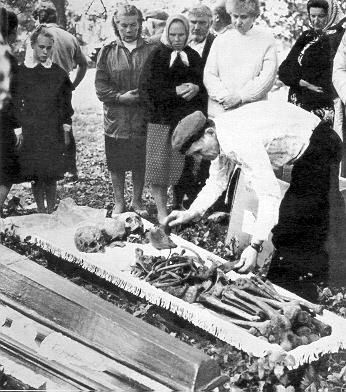
Lithuanians pay homage to the remains of partisans who continued the struggle for
Lithuanian independence after the Soviets re-occupied their country in 1944.
Photo by. E. Šulaitis.
A deep-rooted opposition to the Soviet occupation persists. In the 1970s national and religious dissent intensified giving rise in March 1972 to "The Chronicle of the Catholic Church in Lithuania," which then continued to appear four to seven times a year. It was the first clandestine publication since the suppression in 1952 of the resistance movement and its press. Some issues were translated into Russian and disseminated among other dissident groups in the Soviet Union. In essence, "The Chronicle" became the mouthpiece for the Lithuanian civil and human rights movement.
III. Emigres Efforts and U.S. Response
Various Baltic organizations in the free world—the Supreme Committee for the Liberation of Lithuania, the Lithuanian American Community, the Estonian American National Council, the American Latvian Association, the Joint Baltic American National Committee, and others— continued to solicit governments (e.g. the United States, Canada, Australia) and international bodies (the United Nations, the European Parliament, the World Court) to recognize and support the Baltic nations' legitimate quest for regaining independence.
One of the most potent instruments of moral support over the decades has been the policy of Nonrecognition of Forcible Seizure of Territory (the Stimson Doctrine of 1932) which the U.S. State Department adopted on July 23, 1940, after the Soviet occupation of Estonia, Latvia, and Lithuania. Under the nonrecognition policy their respective diplomatic and consular activities continue in the United States. At the end of the Second World War, the nonrecognition policy was extended into the realm of human rights, when the Western Allies refused to consider Baltic refugees as "Soviet citizens," thus legally preventing their forcible repatriation and probable imprisonment, if not death, by the Soviet Union.13 U.S. officials, including Presidents, have made public statements reaffirming the right of the Baltic states to independence, and have given assurances that the 1975 Helsinki—Final Act would in no way affect the nonrecognition policy.
Over the years most European states, as well as Canada and Australia, have followed the nonrecognition policy of the United States, except for Finland and Sweden, whose positions remained ambiguous until recently, when Sweden decided to favor Lithuania's independence.
In the presence of momentous changes taking place in the Baltic republics and in the Soviet Union itself, the U.S. appeared to re-evaluate its previously unequivocal moral support for the Baltic people. At one point the administration of President Bush included the political struggle for Baltic states' independence among "... (Gorbachev's) internal political problems . . . "14 thus leading some to believe that it subordinated the policy of nonrecognition to support for Gorbachev and his programs of "glasnost" and "perestroika."
However, soon after Lithuania declared the restoration of its independence from the Soviet Union on March 11, 1990, the Bush administration issued a statement urging the Soviet Union to "respect the will" of the Lithuanian people and to enter into "immediate constructive negotiations" with the Republic of Lithuania.15
1 Albertas Gerutis,
"Independent Lithuania," Lithuania: 700 Years,
ed. Albertas Gerutis (New York: Manyland Books, 1969), p. 155.
2 Supreme Committee for the
Liberation of Lithuania, Memorandum on the Restoration of
Lithuania's Independence (The Lithuanian National
Foundation, Inc., 1988), p. 4.
3 Ibid., p. 5.
4 Bronis J. Kaslas, The USSR-German Aggression Against Lithuania (New York: Robert
Speller and Sons, Publishers, Inc., 1973). p. 96.
5 Kaslas, op. cit., p. 111.
6 Ibid., pp. 129-130.
7 Memorandum, p.
56.
8 Albertas Gerutis,
"Occupied Lithuania," Lithuania: 700 Years, pp.
284-285. See also "Strictly Secret Order of the People's
Commissar Serov for the Interior of Lithuanian SSR in 1940. Order
No. 0054," Lituanus, Vol. 34, No. 4 (1988), 48-70.
9 Memorandum, p. 52.
10 "Antroji Pirčiupio Tragedija," Alytaus Sajūdis (Lithuania) March 17,
1989.
11 Memorandum, p. 48
12 V. Stanley Vardys,
"The Partisan Movement in Postwar Lithuania," Lithuania
Under the Soviets: Portrait of a Nation 1940-65, ed. V.
Stanley Vardys (New York: Frederick A. Praeger, Pub. 1965), p.
108.
13 William J.H. Hough, III,
"The Annexation of the Baltic States and its Effect on the
Development of Law Prohibiting Forcible Seizure of
Territory," New York Law School Journal of International
and Comparative Law, Vol. 6, No. 2 (Winter 1985) 403-405.
14 David Remnick,
"Gorbachev Urges Lithuanians Not to Press for
Independence," The Washington Post, Jan. 12, 1990, p.
A 26.
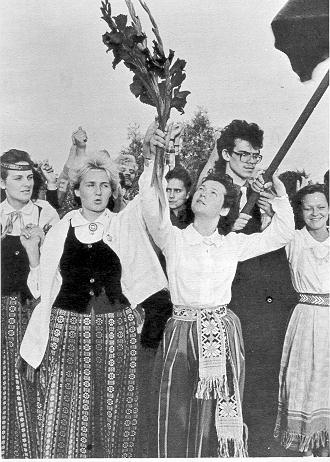
At the Lithuanian-Latvian border, one part of the human chain spanning
Estonia, Latvia, and Lithuania; August 23, 1989.
Photo K. Sverys